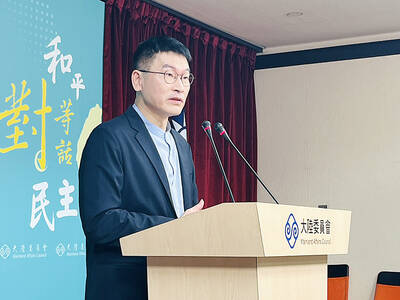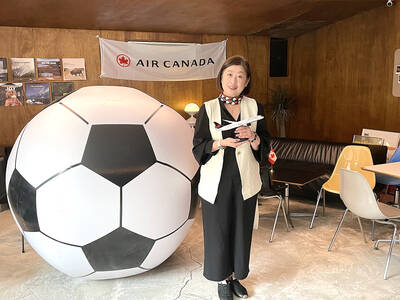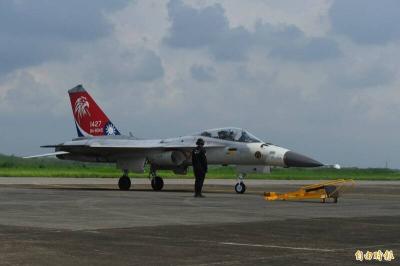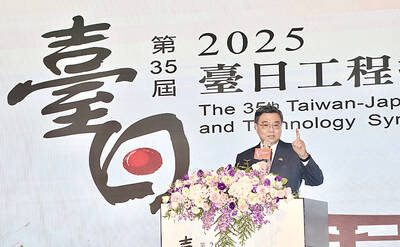Chinese Nationalist Party (KMT) presidential candidate Eric Chu (朱立倫) yesterday unveiled a tentative plan to visit the US early next month, which he said would focus on cross-strait ties and US-Taiwan trade relations.
Chu made the statement during a television interview, one day after he said — following his meeting with American Institute in Taiwan Director Kin Moy — that his decision on whether to visit the US would be based on the schedule of his presidential campaign.
“Given that [the Central Election Commission] is to begin accepting official presidential candidate applications late next month, which roughly coincides with the Thanksgiving holidays, my visit to the US has been tentatively scheduled for the beginning or middle of next month,” Chu said.
Chu, who replaced Deputy Legislative Speaker Hung Hsiu-chu (洪秀柱) as the KMT’s presidential candidate on Saturday, said further information regarding his visit would be made public once both sides have worked out the details.
Due to the proximity of January’s presidential election, Chu — who is also KMT chairman and New Taipei City mayor — said he might not have the time to visit other nations before the ballot.
“Instead, I will communicate with officials in Japan, Southeast Asian nations and European countries via our representatives there or their representatives stationed here, so that they can better understand the KMT’s policies and my campaign objectives,” he said.
Chu’s upcoming US visit is bound to be compared with a 12-day landmark visit to six US cities made by Democratic Progressive Party (DPP) presidential candidate Tsai Ing-wen (蔡英文) in late May, with the rankings of the US officials the two candidates meet carefully parsed.
Chu said that as the cross-strait relationship is closely intertwined with peace and stability in the Asia-Pacific region, it would be the focus of his discussions during his visit.
“The KMT has long-promoted policies conducive to cross-strait stability. Washington also agrees with the party’s use of the [so-called] ‘1992 consensus’ as the basis for maintaining peaceful development across the Taiwan Strait,” Chu said, adding that the future direction of cross-strait developments would also be deliberated.
The “1992 consensus,” a term former Mainland Affairs Council chairman Su Chi (蘇起) admitted making up in 2000, refers to a tacit understanding between the KMT and the Chinese government that both sides acknowledge there is “one China,” with each side having its own interpretation of what “China” means.
Aside from cross-strait relations, Chu said bilateral trade was also an integral part of US-Taiwan ties, with the latest round of Trade and Investment Framework Agreement (TIFA) talks between the two sides on Oct. 1 touching on the issue of US pork imports and agricultural trade.
While the two nations have yet to reach a consensus on these issues, the US is believed to have confidence in Taiwan’s trade policies, Chu added.
Chu said his primary goals for the planned visit included pushing for a continuation of friendly Taiwan-US ties in various dimensions, including politics, economy and cultural exchanges.
“We also aim to reassure Washington that the KMT plans to continue being a peacemaker across the Taiwan Strait rather than a troublemaker,” he said.
Separately yesterday, Tsai said she would be happy to see anyone making a positive contribution toward Taiwan-US relations, regardless of their party affiliation.
“Diplomacy is something that we all will have to work hard on, regardless of party affiliation,” Tsai said. “The DPP has worked hard and communicated with different parties, the fruits of which can be shared by all, and I would be happy for Chu to take the trip based on the basis we have built.”
Asked if the Chu would receive a higher-status reception, Tsai said she would be happy if Chu could “open up more spaces.”
“It’s a good thing that, each time someone goes [to the US], we open up more space in Taiwan-US relations,” Tsai said.
Additional reporting by Loa Iok-sin

LOW RISK: Most nations do not extradite people accused of political crimes, and the UN says extradition can only happen if the act is a crime in both countries, an official said China yesterday issued wanted notices for two Taiwanese influencers, accusing them of committing “separatist acts” by criticizing Beijing, amid broadening concerns over China’s state-directed transnational repression. The Quanzhou Public Security Bureau in a notice posted online said police are offering a reward of up to 25,000 yuan (US$3,523) for information that could contribute to the investigation or apprehension of pro-Taiwanese independence YouTuber Wen Tzu-yu (溫子渝),who is known as Pa Chiung (八炯) online, and rapper Chen Po-yuan (陳柏源). Wen and Chen are suspected of spreading content that supported secession from China, slandered Chinese policies that benefit Taiwanese and discrimination against Chinese spouses of

PROMOTION: Travelers who want a free stopover must book their flights with designated travel agents, such as Lion Travel, Holiday Tours, Cola Tour and Life Tours Air Canada yesterday said it is offering Taiwanese travelers who are headed to North America free stopovers if they transit though airports in Japan and South Korea. The promotion was launched in response to a potential rise in demand for flights to North America in June and July next year, when the US, Canada and Mexico are scheduled to jointly host the FIFA World Cup, Air Canada said. Air Canada offers services to 13 of the 16 host cities of the tournament’s soccer games, including Toronto and Vancouver; Mexico City, Guadalajara and Monterrey in Mexico; Atlanta, Georgia; Boston; Dallas; Houston;

The US approved the possible sale to Taiwan of fighter jet spare and repair parts for US$330 million, the Pentagon said late yesterday, marking the first such potential transaction since US President Donald Trump took office in January. "The proposed sale will improve the recipient's capability to meet current and future threats by maintaining the operational readiness of the recipient's fleet of F-16, C-130," and other aircraft, the Pentagon said in a statement. Trump previously said that Chinese President Xi Jinping (習近平) has told him he would not invade Taiwan while the Republican leader is in office. The announcement of the possible arms

ALIGNED THINKING: Taiwan and Japan have a mutual interest in trade, culture and engineering, and can work together for stability, Cho Jung-tai said Taiwan and Japan are two like-minded countries willing to work together to form a “safety barrier” in the Indo-Pacific region, Premier Cho Jung-tai (卓榮泰) yesterday said at the opening ceremony of the 35th Taiwan-Japan Modern Engineering and Technology Symposium in Taipei. Taiwan and Japan are close geographically and closer emotionally, he added. Citing the overflowing of a barrier lake in the Mataian River (馬太鞍溪) in September, Cho said the submersible water level sensors given by Japan during the disaster helped Taiwan monitor the lake’s water levels more accurately. Japan also provided a lot of vaccines early in the outbreak of the COVID-19 pandemic,